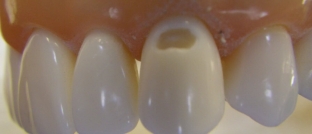Cervical caries – the most aggressive and dangerous type of caries, which affects the area of the tooth adjacent to the gum. This location of carious damage is associated with an increased risk of rapid penetration of the infection deep into the tooth and, accordingly, its loss. The thinness of the enamel layer in the neck of the tooth determines the prevalence of this type of caries, and ignoring the problem for a long time is fraught with dangerous consequences. Therefore, estet-portal.com in this article will provide important information about the causes, signs of the appearance of this pathological process, as well as methods of dental treatment in this case.
What causes a tooth to be affected by cervical caries?
As a rule, the causes of caries are the same for all its types, although they have not been precisely established. It is known that a certain role in the development of caries is played by cariogenic microorganisms, the quality and quantity of saliva, genetic factors, physiological features of the structure of the jaw, nutrition and oral hygiene, exposure to aggressive substances from the outside.
The main cause of tooth damage cervical caries is considered to be inadequate oral care, the likelihood of tooth decay in this particular place increases due to the inaccessibility of the neck for a toothbrush.
Cervical caries – the most aggressive and dangerous type of caries that affects the area of the tooth adjacent to the gum.
Given the frequency and high likelihood of cervical caries, you need to know:
- symptoms of cervical caries;
- methods of cervical caries treatment;
- Ways to prevent cervical caries.
Symptoms of cervical caries: how to recognize the pathology
The first thing a patient should do for timely detection of cervical caries, – visit the dentist regularly. Since this type of caries very quickly affects the tissues of the tooth, there is a high risk of developing pulpitis and periodontitis against the background of this pathology, if it is not recognized and stopped in time.
Cervical caries can be recognized by the following symptoms:
- darkening of the tooth enamel near the gums;
- tooth sensitivity to temperatures, as well as spicy, sour and sweet foods;
- appearance of a cavity in the tooth near the gum;
- pain.

You should consult a dentist if you experience sensitivity and darkening of the enamel, without waiting for the appearance of more pronounced symptoms of caries.
How is cervical caries treated?
It is important to note that going to the doctor in the early stages of caries greatly facilitates the treatment process. In this case, the dentist resorts to professional remineralization of tooth enamel and recommends the patient to follow the rules of oral hygiene, use special toothpastes and eat right.
You should consult a dentist if you experience sensitivity and darkening of the enamel, without waiting for the appearance of more pronounced symptoms of caries.
At later stages, the treatment of cervical caries is indispensable without a more complex procedure consisting of the following steps:
- professional teeth cleaning;
- pain relief;
- rejection of the gums (if there is a lesion under it);
- crown preparation and cavity cleaning;
- layer-by-layer installation of a seal with preliminary treatment of the affected area with an adhesive;
- surface shaping and polishing.
In case of extensive damage to the tooth surface, the doctor may also recommend the installation of veneers.
Prevention of cervical caries: how to protect the tooth from damage
All doctors unanimously affirm that prevention is always easier and more profitable than treatment. As for cervical caries, the ways to prevent it are extremely simple and do not require much effort on the part of the patient:
- proper oral hygiene (comprehensive and regular use of toothbrushes, pastes, floss and rinses);
- regular dental check-ups;
- Prophylactic professional teeth cleaning;
- proper nutrition (minimum sweets and starchy foods, maximum healthy vegetables and fruits).
Simple preventive measures will help maintain healthy teeth and protect them from carious destruction, and awareness of the symptoms of cervical caries and timely access to the dentist will save a lot of money and prevent the dangerous consequences of this pathological process.






Add a comment